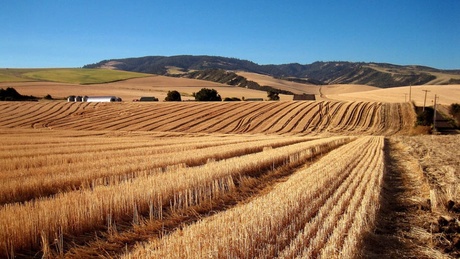forum
library
tutorial
contact

Wheat Farmers are Becoming
Long-term Casualties of Trump's Trade Wars
by Jimmie Musick
Capital Press, August 9, 2018
|
the film forum library tutorial contact |

|
Wheat Farmers are Becoming
by Jimmie Musick
|
The Trump administration needs to stop alienating our top trading partners
and restore certainty to the agricultural marketplace.
 There's a reason it's called a trade war. There are casualties. The first of victims on this battlefield are American farmers. Like any battle, the element of surprise can be advantageous, but wheat farmers in America are the ones standing by in shock.
There's a reason it's called a trade war. There are casualties. The first of victims on this battlefield are American farmers. Like any battle, the element of surprise can be advantageous, but wheat farmers in America are the ones standing by in shock.
Those in American agriculture rightfully worry that the Administration's unconventional approach to trade may create long-term financial problems. The United States' withdrawal from the Trans Pacific Partnership (TPP) continues to harm growers and further puts the country at a competitive disadvantage.
The Administration's flippant rhetoric around the North American Free Trade Agreement (NAFTA) has made the United States appear to Canada and Mexico as an unreliable trading partner.
Lastly, the trade war between the U.S. and China could have a devastating and lasting effect on wheat farmers.
Japan is the one of the largest, most valuable markets for U.S. wheat in the world. Of the 6 million metric tons (MMT) of wheat it imports each year, more than half is grown in American fields.
The United States absence from the new Trans-Pacific Partnership (TPP-11) continues to threaten America's wheat farmers by putting us at an economic disadvantage to our largest competitors in this market, Canada and Australia. Once implemented, both countries, who are parties to TPP-11, would face a lower effective tariff on their wheat, which could reduce the U.S. market share from 51 percent to 23 percent, according to industry estimates. This represents a loss at today's wheat prices of about $500 million per year, which would cause the entire U.S. wheat supply chain to suffer significant economic damage and job loss.
Mexico is a top 10 market for the three largest classes of U.S. wheat and the largest market overall. This is almost entirely attributable to the North American Free-Trade Agreement (NAFTA). U.S. wheat exports to Mexico jumped 400 percent in the 10 years after the agreement went into effect compared to the 10 years before. In April 2017, the Administration threatened to withdraw from NAFTA. As a result, Mexican buyers have sought to diversify as they increasingly view the Administration's trade threats as indicators that the United States is no longer a reliable partner.
So far this year, sales to Mexico are more than a million metric tons lower than they were at this point last year. The fear from agriculture groups and farmers across the country is not only focused on trade retaliation, but also being able to rebuild a trade relationship with Canada and Mexico moving forward.
From March to June, over the past three years, Chinese flour milling companies and state-run importers purchased an average of about 20 million bushels of U.S. wheat, delivering a return of $145 million to American farmers and grain handlers. When the Administration announced in March that it would impose sweeping tariffs on Chinese steel and aluminum imports, buyers were unable to accept the risk of escalating import prices and stopped making new purchases of U.S. wheat, including soft white wheat grown in the Pacific Northwest.
A 25 percent import tariff on American wheat means that China will likely purchase wheat from our competitors instead. The exchange of punitive tariffs between Washington and Beijing today represents the next phase of what could be a long and difficult struggle that will likely inflict more pain before we reach an unknown resolution.
The current trade climate is hindering the livelihood of America's hard-working farm families. Implementation of TPP-11, without the United States, could demolish more than 60 years of hard work by multiple generations of U.S. farm families to develop a large and loyal market for U.S. wheat in Japan.
The United States needs to negotiate more comprehensive trade agreements like TPP and NAFTA. Growers want trade and not aid. U.S. Wheat Associates estimates that if China and Mexico continue this present course, 2018/19 exports could drop from 27 to 24 MMT, ending stocks would rise to 33 MMT, and wheat farmers could be hit by a 75-cent loss per bushel. This results in a value loss of $2.48 billion in 2018/19 alone, a devastating hit to U.S. wheat farmers.
The Administration needs to stop alienating our top trading partners and restore certainty to the agricultural marketplace as soon as possible.
There is more land planted to wheat in the world than any other crop.
It provides 20 percent of the world's caloric consumption.Wheat Facts
by Washington Grain Commission, 2015 / 2016
Pacific Northwest All Wheat Production
Washinton 111.5 million bushels 3.3 million tons Idaho 87.1 million bushels 2.6 million tons Oregon 39.2 million bushels 1.2 million tons Total 237.8 million bushels 7.1 million tons
learn more on topics covered in the film
see the video
read the script
learn the songs
discussion forum
